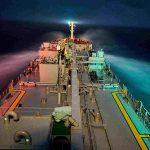Water from the Main Engine fresh water expansion tank is used for cooling purpose in the ship’s main engine. The water in the tank needs to be kept at the required level at all times to ensure that sufficient water is supplied to the engine.
In this article, a peculiar situation has been described, wherein the main engine fresh water tank had to be replenished five or more times a day to supply the necessary amount of fresh water to the engine – Of course, this is excessive.

Excessive leakage of the fresh water tank can be because of several reasons. Some of the main ones are listed below along with their troubleshooting:
1) Leakages from Cylinder Head “O” rings
This happens mainly because of insufficient preheating (below 45 °C) but stops when the engine is running and the jacket cooling water outlet temperature is 80-82 °C due to thermal expansion.
Regular maintenance with use of correct size and type of O-ring and good cleaning of surfaces is the key to resolve this problem.
In some engines, there is an intermediate cylindrical piece, which forms a part of the jacket. If this is not correctly fitted (Mind the dowel pin and see if rubber ring is not oversized), this piece may crack. To cut off this unit, we may need to close the inlet and outlet valves of the concerned cylinder. However, it has been noted that these valves do not hold and a blank is difficult to put.
The jacket cooling water inlet and outlet valves of the main engine must be overhauled on all units during dry docking. Engineers also need to practice how to cut off the fuel to a particular cylinder in correct manner. Trying to figure this out at the last moment is not a good idea.
2) Leakages from Cylinder liner “O” rings.
During cylinder overhauling, engineers should try to pull out the liner and renew the “O” rings after good cleaning of the landing surface.
This process requires time and immobilization of the ship at the ports one of the biggest concerns these days. However, we should be on the look out to carry out this work whenever possible.
3) Leakage from Main Engine Turbocharger Water Cooled Casing:
The turbo charger casing should be cleaned chemically on the water side (do not hard scrape or hammer the casing) after 10 years of operation. Ultrasonic gauging of the casing at the top (near air vent) and at the bottom (mud collects here and circulation is inadequate in this area) is required.
If, unfortunately, the casing develops a crack, it is very difficult to trace and equally difficult to repair. Rigging of air cooling may be resorted to ensure that the oil temperature does not go more than 120 ° C (attached pumps and individual sumps).
4) Leakage from Pump Gland:
With improvement of pump designs (Shinko) and use of mechanical seals, the leakage from pump glands is quite minimal these days.
However, on older engines, renew the pump sleeve and use correct size gland packing, ensuring very less leakage at the gland (follow maker’s advice).
Leakage in Fresh Water Cooler:
Maine engine’s fresh water cooler for jacket cooling water should regularly be cleaned and pressure tested as per the planned maintenance system of the engine room. Any leaking tube must be plugged as per the maker’s instruction.
6) Degraded Cooling Water Property:
Maintaining cooling water quality is of prime importance. Once in 6 months, engineers should send cooling water sample for analysis and also try to keep PH of the water about 8.0-8.5 by giving regular chemical dozing.
There are training videos provided by the chemical suppliers and these should also be viewed by engine room staff to understand the process in a better way.
7) Improper Maintenance and Overhaul:
Marine engineers often overhaul the exhaust valves but do not pay minute attention to the cooling water side by removing the plugs.
It is to note that cylinder heads may also develop cracks with time mostly around air starting valve area. Ship superintendents often ask to get all cylinder heads shifted to workshop for cleaning (during dry dock) and carefully testing for cracks on cylinder head using modern techniques.



Comments are closed